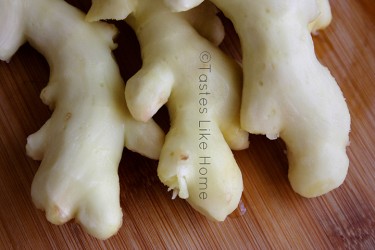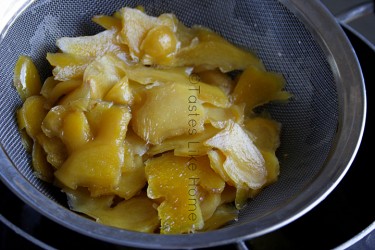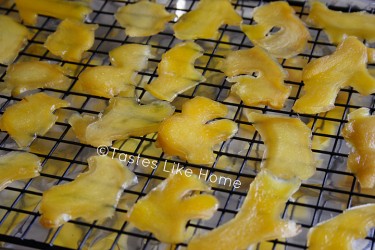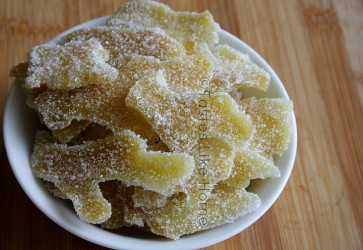Hi Everyone, Hot, spicy, peppery and sweet, candied ginger is a real sweet treat. Yeah, I can rhyme.
Walk into a supermarket or health food store and you are bound to find packets, jars or small containers of candied ginger, also known as crystalized ginger or ginger chews. These store-bought versions of candied ginger frequently cost a pretty penny. However, often they do not live up to the qualities for which they are known. In the Caribbean, just like much of the rest of the world, candied ginger has been used as a remedy for centuries. However, we also love it because, let’s be honest, it tastes real good!
As an ingredient, you can use candied ginger to enliven fruit pies, crisp and crumble toppings. Finely mince it and add to batters for cakes and cookies. It is really great when added to jams, particularly marmalade. Ginger in all its forms is a natural partner with citrus.
 If you’re up for a little kitchen experiment, let me tell you how you can make your own candied ginger. It’s easy and will save you money. Three ingredients are all you need – ginger, sugar and water. When you make your own candied ginger, you have the option of having it dusted with sugar or stored in its own syrup. Talking about the syrup, that is one of the best things (at least for me) about making candied ginger. That syrup has multiple uses. It can be drizzled on to cakes, ice cream and other sweet treats. It can be used to sweeten your tea, lime, lemon, orange or other citrus drinks. The syrup works as a refreshing flavour combination with certain homemade fruits drinks like watermelon, pineapple, golden apple, mango and papaya. You can also use it as a bar syrup to make cocktails and mocktails.
If you’re up for a little kitchen experiment, let me tell you how you can make your own candied ginger. It’s easy and will save you money. Three ingredients are all you need – ginger, sugar and water. When you make your own candied ginger, you have the option of having it dusted with sugar or stored in its own syrup. Talking about the syrup, that is one of the best things (at least for me) about making candied ginger. That syrup has multiple uses. It can be drizzled on to cakes, ice cream and other sweet treats. It can be used to sweeten your tea, lime, lemon, orange or other citrus drinks. The syrup works as a refreshing flavour combination with certain homemade fruits drinks like watermelon, pineapple, golden apple, mango and papaya. You can also use it as a bar syrup to make cocktails and mocktails.
Let’s start with the selection of the key ingredient – ginger. Here in Barbados I can get fresh young ginger because ginger is grown here. Ginger takes about 6 months to grow before harvesting so I get it twice a year from a particular farmer. If you have access to young ginger then get it. The young ginger is juicer, with the fresh flavour and brightness of ginger. It is generally a little less peppery than the mature ginger, however, the young ginger I get here in Barbados packs some heat. I think that it is due to the type of soil here. I don’t mind. I love it!
The ginger that we get all year round is mature and that can most certainly be candied. The main thing to look out for is that the skin of the ginger should be shiny and not dull or wrinkled. The ginger should be plump and not shrunken.
To peel the ginger, use a soupspoon or teaspoon, it makes for easy work when peeling ginger and gets into all the nooks and crannies. With young ginger, the skin is thin and comes off easily with a firm vegetable brush.
Here are the ingredients by quantities; then follow the instructions and photographs.
- 1 pound peeled, fresh root ginger
- 4 cups tap water
- 4 cups white sugar, plus extra for tossing
Special equipment: a large baking sheet with a cooling/wire rack.

STEP 1
Brush the ginger clean, removing any excess soil.

STEP 2
Peel the ginger and cut into thin slices.

STEP 3
Add the sugar and water to a heavy-bottomed pot and place over medium heat. Stir until the sugar is dissolved. Add the sliced ginger and give the pot a good stir. Bring it to a boil then reduce the heat to low and cook for 30 minutes or until the ginger is tender. Drain the ginger over a large heatproof bowl (to catch the syrup). Let the ginger drain well.

STEP 4
Spread the ginger out onto the wire rack (that’s inserted into the sheet pan) and let cool completely and air-dry. The time of drying process will vary depending on your location and the temperature. I let mine air dry overnight. On another occasion it was dried in 10 hours. When the ginger is properly dried it will be tacky to the touch but not wet.

STEP 5
Add some white sugar to a large bowl, then the ginger and keep tossing until the sugar adheres to the ginger. Store in an airtight container. Store the cooled syrup for multiple uses later.
If you do not wish to toss your candied ginger in sugar, drain the cooked ginger and add it to a sterilized jar and cover with syrup. Let cool completely then refrigerate. Store the excess syrup in the refrigerator in a corked bottle.
Enjoy!
Cynthia









